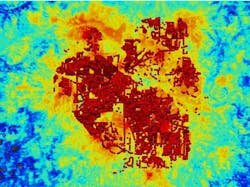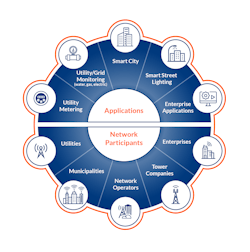Driving Change in the Water Utility Industry
Technology innovation is continuously disrupting major industries, driving operational efficiencies, optimizing the use of natural resources, and supporting economic development. Over the past decade, several cycles of technology innovation and optimization have taken place throughout the utilities market, providing sophisticated and seamless ways of improving legacy systems with modern solutions to drive advancements in critical infrastructure and service delivery. This innovation and the pace of change are highly evident in the residential and commercial water metering and water management markets, and are being driven by the introduction of new network technologies and a variety of low-cost, network-connected sensors.
With water systems built during previous generations reaching or exceeding the end of their useful life, the renewal and replacement of aging water and wastewater infrastructure is the top challenge facing water utilities in the United States. In fact, this single critical issue has topped the American Water Works Association (AWWA) State of the Water Industry Report for the last seven years. One area of active innovation directly addressing this challenge is the adoption of Advanced Metering Infrastructure (AMI). AMI is often narrowly viewed as a replacement for walk by/drive by Automatic Meter Reading (AMR) and read-to-bill processes. However, beyond this singular process change, utilities are finding that the wireless communication networks deployed for modern AMI systems are ideal for supporting multiple water metering and management applications. This capability is significantly increasing both the economic and environmental value of transitioning away from legacy manual and proprietary systems.
With advancements in automated metering and wireless data collection sensors, water utilities can now utilize their advanced metering infrastructure to reduce water loss through improved leak detection, streamline billing through enhanced water flow monitoring, and implement new rate structures to incentivize water conservation. The two-way communication between a utility and AMI-enabled metering endpoints also delivers additional actionable data to Supervisory Control and Data Acquisition (SCADA) systems, allowing for improved infrastructure diagnostics, advanced data analytics, and the ability to enhance field operations. Further, consumers benefit from behind-the-meter leak detection solutions and detailed information about their water consumption which can lead to more efficient water use and lower water bills.
In fact, water metering has been identified as one of the fastest growing segments of the global LPWAN solutions market, with millions of smart meters being deployed globally. IHS Markit forecasts the global smart water meter market will surpass $2 billion in 2020 and smart meters and utility applications connected via LPWAN technologies will total more than 300 million by 2023. This growth in LPWAN solutions is being led by open, standards-based technologies such as LoRaWAN, a Low Power Wide Area networking protocol which addresses the inefficiencies, high operational costs, and vendor lock-in associated with proprietary solutions. LoRaWAN is designed to wirelessly connect low-cost, battery-operated sensors over long distances, offering the propagation characteristics, extended battery life, ease of deployment, and cost profile the water industry requires to modernize its infrastructure and service delivery. With LoRaWAN, water utilities can more effectively measure usage data and trends in urban environments, rural areas, indoors and underground, both wirelessly and without manual intervention.
The Importance of Network Design
Today’s advanced metering systems require complex network design, expert construction, and ongoing support. To provide the carrier-grade service levels required for critical public infrastructure, network operators must support several challenging real-world requirements. Networks must include capacity for hundreds of thousands of water meters and sensors deployed over thousands of square miles in a single district, the ability to provide connectivity in difficult RF conditions such as below-grade meter reading, end-to-end security, and flexible deployment and business engagement models.
Flexible deployment models offered by forward thinking LoRaWAN network operators and AMI solution providers allow utilities to deploy AMI networks that are tailored for their unique geographical and application-specific connectivity requirements. These include public Network-as-a-Service (NaaS), utility owned and operated networks, municipal networks, and hybrid variations.
In an operator-managed cloud-based systems approach, the network operator installs the network gateways (data collectors), ensures high-availability connectivity service, and maintains operation of the network while the utility or their meter solution partner is responsible for the meter and endpoint maintenance. AMI solutions delivered in a Software-as-a-Service (SaaS) model further benefit utilities by removing additional back-end management of the AMI interface and application. This modern, cloud-based and cooperative model allows utilities to focus on their core business without the operational burden of building and maintaining the system infrastructure.
The different network ownership models provided by LoRaWAN operators uniquely support the future business needs of utilities as they consider deploying additional water management and resource conservation solutions. Flexibility in network design, cost-effective network deployment and management, and the business engagement models facilitated by modern network platforms cannot be matched by proprietary solutions or legacy and emerging 3GPP networks.
A Foundational Network for Utility and Municipal Engagements
In the same way utility leaders are exploring new ways of improving operational resilience and engaging with customers, their investment in advanced technologies for critical infrastructure provides new opportunities to engage with municipal leaders.
Like many industries and organizations, municipalities have the opportunity to transform their operations and service delivery by making smart technology investments. As municipalities explore opportunities to deliver city-wide Internet of Things (IoT) services, they are in a unique position to partner with first-movers in their region to deploy and manage smart city solutions on a common and open network architecture. Partnering with water utilities, for example, provides a unique opportunity to create a shared LoRaWAN network infrastructure capable of supporting a wide range of commercial and citizen-facing applications.
LoRaWAN networks designed for AMI are among the most capable. They are high-density, built with abundant capacity, and secure. Gateway capacity depends on several factors, but even with conservative modeling, a single LoRaWAN gateway can support several hundreds of thousands of meter endpoints, representing a small fraction of the total network capacity. With robust and market-tested security being critical to protect public health, ensure safety, and prevent service disruptions, LoRaWAN is highly capable of handling the requirements for secure wireless delivery of water meter data and addresses many of the more complex technical and commercial challenges faced in the industry. The LoRaWAN protocol was built with security as a fundamental part of the network architecture and endpoint deployment best practices are implemented with security as a critical part of the design process.
With a dense LoRaWAN network in place to support water metering, municipalities and utilities can partner to rapidly deploy and expand their IoT initiatives. Easy LoRaWAN gateway deployment and cloud-based network management allow for multi-service utilities (water, gas, electric) to deploy applications at a low cost and in a collaborative fashion. Beyond utility metering and monitoring, municipalities can rapidly deploy solutions for waste management, smart parking, environmental monitoring, asset tracking, pest management, public safety, and more.
Open, standards-based technologies and applications, combined with cost-efficient ways of modernizing legacy systems have the potential to change the trajectory of the entire water market sector. Further, shared technology, shared infrastructure, integrated projects and shared costs enable utilities and cities to drive efficiencies, deliver enhanced services to citizens, engage in sustainable practices, and ultimately gain the full benefits of digital transformation. WW
About the Author

Bruce Chatterley
Bruce Chatterley is an experienced entrepreneur with over 30 years of experience building successful companies. He is currently CEO of Senet Inc., a developer of cloud-based software and services used for the on-demand deployment of IoT networks, based upon the LoRaWAN standard.

